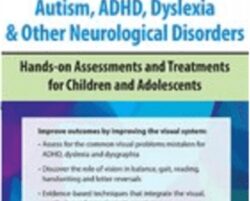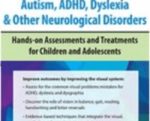Do you work with children with ADHD, dysgraphia, dyslexia, letter reversals and reading problems that do not respond to typical treatments?Are you frustrated by a lack of progress in children who exhibit poor:Reading skillsHandwritingPostureVisual-motor integrationBall-handling skillsVisual processing and visual perceptual skills?Do you know a child that cannot catch a ball and frequently trips? What about the child with autism that studies small objects in the peripheral? Or a low tone child that struggles with handwriting? These problems may be related to an eye movement or near vision focusing difficulties.Watch this live webcast and learn to find the root of these problems by learning to assess eye movements and near vision.You will learn evidence-based techniques to improve vision that integrate the visual, vestibular and proprioceptive systems using interventions developed by an occupational therapist that will get results.Explore the anatomy and physiology of the visual system from cornea to cortex.Recognize eye movement disorders associated with ADHD, dysgraphia, and dyslexia and improve outcomes for these diagnoses.Demonstrate techniques to assess for eye movement difficulties and near vision using readily available tools.Communicate the role of vision in gait, balance and posture.Recognize the signs of a faulty near-vision system and the implications of reading and visual motor integration.Demonstrate evidence-based techniques to treat eye movement defects.Articulate common ICD-10 codes for eye movement disorders.The Pediatric Eye ExamOphthalmology or Optometry or Vision TherapyCase study BeccaAnatomy of the Visual SystemThe anatomy of the OrbitMuscles of the eyeThe visual pathways of vision in the brainMagnocelluar vs Parvocellular StreamCongenital Visual ProblemsColobomaOptic Nerve Hypoplasia: Case study BlakeRetinopathy of PrematurityThe role of therapists in Cortical Visual ImpairmentCommon Eye Movement Problems Affecting PT and OT OutcomesSuppressionStrabismus, Anisometropia, and amblyopiaNystagmusConvergence InsufficiencyAccommodative problemsAssessment of Eye Movements and Near VisionTrackingSaccadesConvergenceThe Near Vision System: case study RaleighLab TimeTreatment Techniques for the Visual SystemDIY and High-Tech solutionsThe Brock String and Hart ChartPrism and lensesHolistic treatment techniquesClinic videosCase studies describing treatmentVision Tools for Balance, Gait and PostureBiNasal Occulsion”Glasses that fix toe-walking”Case studies: Charlotte; AudryMid-Line Shift Syndrome: Case study BenVision Problems Associated with:TBI, Stroke and ConcussionADHD: Case study Bryson and NateDyslexiaAutismSensory Modulation Postural Dysfunction: Case study JonMid-Level Visual ProcessesVisual motor integration tips: Case study DavidVisual processing disorderVisual perceptual deficitsCoding and Goals for Eye Movement ProblemsICD-10 codes common for eye movement problemsBasic goals for eye movement problemsResources for more informationTag: Vision Techniques for Eye Movement Disorders Associated with Autism, ADHD, Dyslexia & Other Neurological Disorders: Hands-on Assessments and Treatments for Children and Adolescents – Robert Constantine Review. Vision Techniques for Eye Movement Disorders Associated with Autism, ADHD, Dyslexia & Other Neurological Disorders: Hands-on Assessments and Treatments for Children and Adolescents – Robert Constantine download. Vision Techniques for Eye Movement Disorders Associated with Autism, ADHD, Dyslexia & Other Neurological Disorders: Hands-on Assessments and Treatments for Children and Adolescents – Robert Constantine discount.
Vision Techniques for Eye Movement Disorders Associated with Autism, ADHD, Dyslexia & Other Neurological Disorders: Hands-on Assessments and Treatments for Children and Adolescents – Robert Constantine
₹13,778.00







